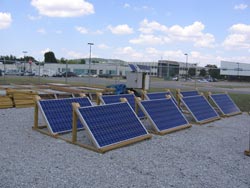Researchers Develop Runway Anti-Icing System

The researchers test site shows photovoltaic panels (foreground) providing power to a battery-storage system and concrete panels (background).<br>
Engineering researchers at the University of Arkansas are developing an anti-icing system that could make airport runways safer and less expensive to maintain during winter months. The approach uses a conventional photovoltaic system to supply energy to a conductive concrete slab that would function as a surface overlay on runways. Energy conducted throughout the slabs allows them to continually maintain temperatures above freezing and thus prevent accumulation of snow and ice.
“Major U.S. airports do a good job of keeping runways safe and clear of ice and snow,” said Ernie Heymsfield, associate professor of civil engineering. “But this is a labor-intensive and expensive process, especially for northern airports. The St. Paul, Minnesota, airport, for example, budgets approximately $4 million annually for snow removal. For various reasons, including the fact that it is grid-energy independent, our system could put a huge dent in this budget.”
After initial design, Heymsfield now leads a team of researchers who are testing the slab at the university’s Engineering Research Center in south Fayetteville. The slab consists of two layers above existing soil and a gravel base.
The bottom layer – the first layer above the gravel base – is a 20-foot by 24-foot base slab that does not contain any conductive properties. Above the base slab is a surface layer that consists of twelve overlay panels, each 4 feet by 10 feet. Ten of these panels are made with a special concrete mix that conducts heat much like a cast-iron skillet exposed to a stove burner. Two control panels made of conventional concrete mix provide a basis for comparison to the conductive panels.
The photovoltaic system supplies DC power to electrodes embedded within the conductive concrete panels. The components of the photovoltaic system include an array of cells that convert sunlight into energy, a battery storage bank and a regulator to control energy between the array and the batteries. Energy is transferred from the batteries to the electrodes. The intrinsic thermal-mass properties of the concrete mix also enable the slab to absorb large amounts of heat from ambient temperature conditions, which minimizes the cost of the photovoltaic system.
Preliminary tests showed that although heat flow was non-uniform and concentrated on an area near the energy source, the conductive panels responded much faster to extreme surface temperature reductions after the researchers applied a thin layer of ice. Heymsfield said the non-uniformity and concentration of heat flow will be corrected by modifying the electrode configuration. The researchers will continue testing the system through the 2011-12 winter season.
If successful, the modified pavement could be an alternative to current snow and ice-removal methods, which include plowing, blowing and applying chemicals. There are various pavement de-icing methods, including chemical, thermal, electric and microwave, but these methods are expensive because they rely on grid power or require a high number of airport personnel.
Since 1978, slush, ice or snow has contributed to approximately 100 accidents and incidents on U.S. runways involving jet or turboprop aircraft weighing more than 5,600 pounds.
Initial results of the study will be presented at the Transportation Research Board’s annual meeting in January 2012.
CONTACTS:
Ernie Heymsfield, associate professor, civil engineering
College of Engineering
479-575-7586, ernie@uark.edu
Matt McGowan, science and research communications officer
University Relations
479-575-4246, dmcgowa@uark.edu
Media Contact
More Information:
http://www.uark.eduAll latest news from the category: Power and Electrical Engineering
This topic covers issues related to energy generation, conversion, transportation and consumption and how the industry is addressing the challenge of energy efficiency in general.
innovations-report provides in-depth and informative reports and articles on subjects ranging from wind energy, fuel cell technology, solar energy, geothermal energy, petroleum, gas, nuclear engineering, alternative energy and energy efficiency to fusion, hydrogen and superconductor technologies.
Newest articles

Properties of new materials for microchips
… can now be measured well. Reseachers of Delft University of Technology demonstrated measuring performance properties of ultrathin silicon membranes. Making ever smaller and more powerful chips requires new ultrathin…

Floating solar’s potential
… to support sustainable development by addressing climate, water, and energy goals holistically. A new study published this week in Nature Energy raises the potential for floating solar photovoltaics (FPV)…

Skyrmions move at record speeds
… a step towards the computing of the future. An international research team led by scientists from the CNRS1 has discovered that the magnetic nanobubbles2 known as skyrmions can be…





















